engine coolant SUZUKI XL7 2007 2.G User Guide
[x] Cancel search | Manufacturer: SUZUKI, Model Year: 2007, Model line: XL7, Model: SUZUKI XL7 2007 2.GPages: 274, PDF Size: 6.12 MB
Page 196 of 274
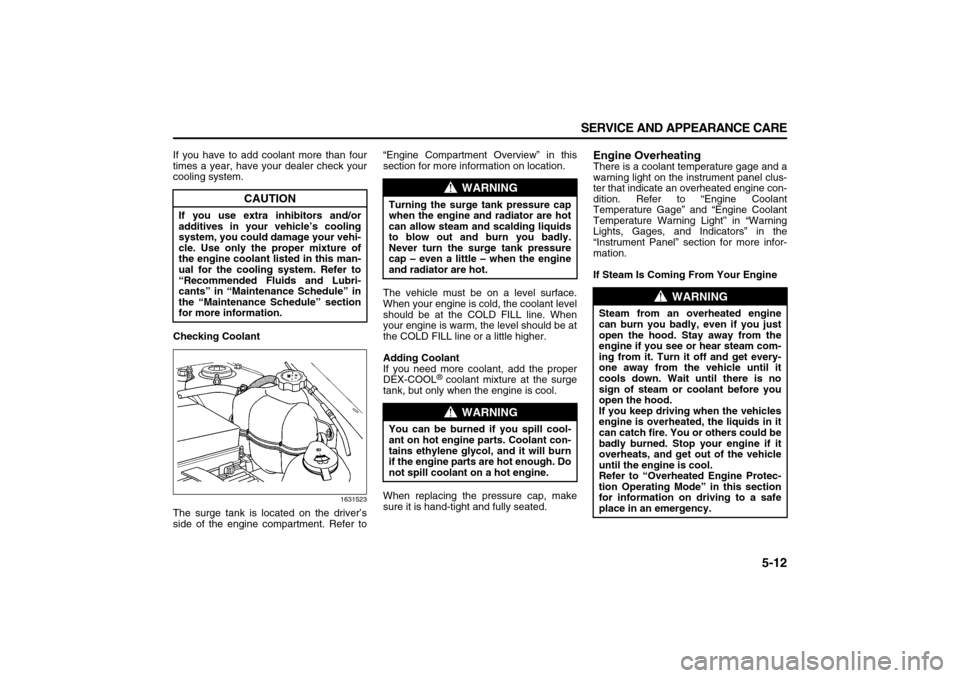
5-12 SERVICE AND APPEARANCE CARE
78J00-03E
If you have to add coolant more than four
times a year, have your dealer check your
cooling system.
Checking Coolant
1631523
The surge tank is located on the driver’s
side of the engine compartment. Refer to“Engine Compartment Overview” in this
section for more information on location.
The vehicle must be on a level surface.
When your engine is cold, the coolant level
should be at the COLD FILL line. When
your engine is warm, the level should be at
the COLD FILL line or a little higher.
Adding Coolant
If you need more coolant, add the proper
DEX-COOL
® coolant mixture at the surge
tank, but only when the engine is cool.
When replacing the pressure cap, make
sure it is hand-tight and fully seated.
Engine OverheatingThere is a coolant temperature gage and a
warning light on the instrument panel clus-
ter that indicate an overheated engine con-
dition. Refer to “Engine Coolant
Temperature Gage” and “Engine Coolant
Temperature Warning Light” in “Warning
Lights, Gages, and Indicators” in the
“Instrument Panel” section for more infor-
mation.
If Steam Is Coming From Your Engine
CAUTION
If you use extra inhibitors and/or
additives in your vehicle’s cooling
system, you could damage your vehi-
cle. Use only the proper mixture of
the engine coolant listed in this man-
ual for the cooling system. Refer to
“Recommended Fluids and Lubri-
cants” in “Maintenance Schedule” in
the “Maintenance Schedule” section
for more information.
WARNING
Turning the surge tank pressure cap
when the engine and radiator are hot
can allow steam and scalding liquids
to blow out and burn you badly.
Never turn the surge tank pressure
cap – even a little – when the engine
and radiator are hot.
WARNING
You can be burned if you spill cool-
ant on hot engine parts. Coolant con-
tains ethylene glycol, and it will burn
if the engine parts are hot enough. Do
not spill coolant on a hot engine.
WARNING
Steam from an overheated engine
can burn you badly, even if you just
open the hood. Stay away from the
engine if you see or hear steam com-
ing from it. Turn it off and get every-
one away from the vehicle until it
cools down. Wait until there is no
sign of steam or coolant before you
open the hood.
If you keep driving when the vehicles
engine is overheated, the liquids in it
can catch fire. You or others could be
badly burned. Stop your engine if it
overheats, and get out of the vehicle
until the engine is cool.
Refer to “Overheated Engine Protec-
tion Operating Mode” in this section
for information on driving to a safe
place in an emergency.
Page 197 of 274
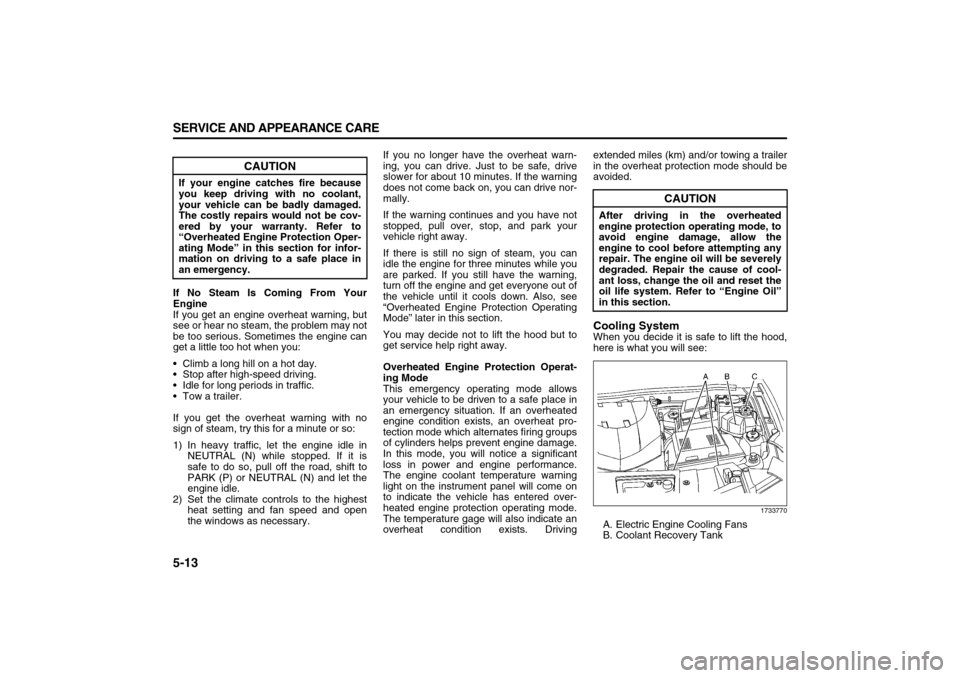
5-13 SERVICE AND APPEARANCE CARE
78J00-03E
If No Steam Is Coming From Your
Engine
If you get an engine overheat warning, but
see or hear no steam, the problem may not
be too serious. Sometimes the engine can
get a little too hot when you:
Climb a long hill on a hot day.
Stop after high-speed driving.
Idle for long periods in traffic.
Tow a trailer.
If you get the overheat warning with no
sign of steam, try this for a minute or so:
1) In heavy traffic, let the engine idle in
NEUTRAL (N) while stopped. If it is
safe to do so, pull off the road, shift to
PARK (P) or NEUTRAL (N) and let the
engine idle.
2) Set the climate controls to the highest
heat setting and fan speed and open
the windows as necessary.If you no longer have the overheat warn-
ing, you can drive. Just to be safe, drive
slower for about 10 minutes. If the warning
does not come back on, you can drive nor-
mally.
If the warning continues and you have not
stopped, pull over, stop, and park your
vehicle right away.
If there is still no sign of steam, you can
idle the engine for three minutes while you
are parked. If you still have the warning,
turn off the engine and get everyone out of
the vehicle until it cools down. Also, see
“Overheated Engine Protection Operating
Mode” later in this section.
You may decide not to lift the hood but to
get service help right away.
Overheated Engine Protection Operat-
ing Mode
This emergency operating mode allows
your vehicle to be driven to a safe place in
an emergency situation. If an overheated
engine condition exists, an overheat pro-
tection mode which alternates firing groups
of cylinders helps prevent engine damage.
In this mode, you will notice a significant
loss in power and engine performance.
The engine coolant temperature warning
light on the instrument panel will come on
to indicate the vehicle has entered over-
heated engine protection operating mode.
The temperature gage will also indicate an
overheat condition exists. Drivingextended miles (km) and/or towing a trailer
in the overheat protection mode should be
avoided.
Cooling SystemWhen you decide it is safe to lift the hood,
here is what you will see:
1733770
A. Electric Engine Cooling Fans
B. Coolant Recovery Tank
CAUTION
If your engine catches fire because
you keep driving with no coolant,
your vehicle can be badly damaged.
The costly repairs would not be cov-
ered by your warranty. Refer to
“Overheated Engine Protection Oper-
ating Mode” in this section for infor-
mation on driving to a safe place in
an emergency.
CAUTION
After driving in the overheated
engine protection operating mode, to
avoid engine damage, allow the
engine to cool before attempting any
repair. The engine oil will be severely
degraded. Repair the cause of cool-
ant loss, change the oil and reset the
oil life system. Refer to “Engine Oil”
in this section.
Page 198 of 274
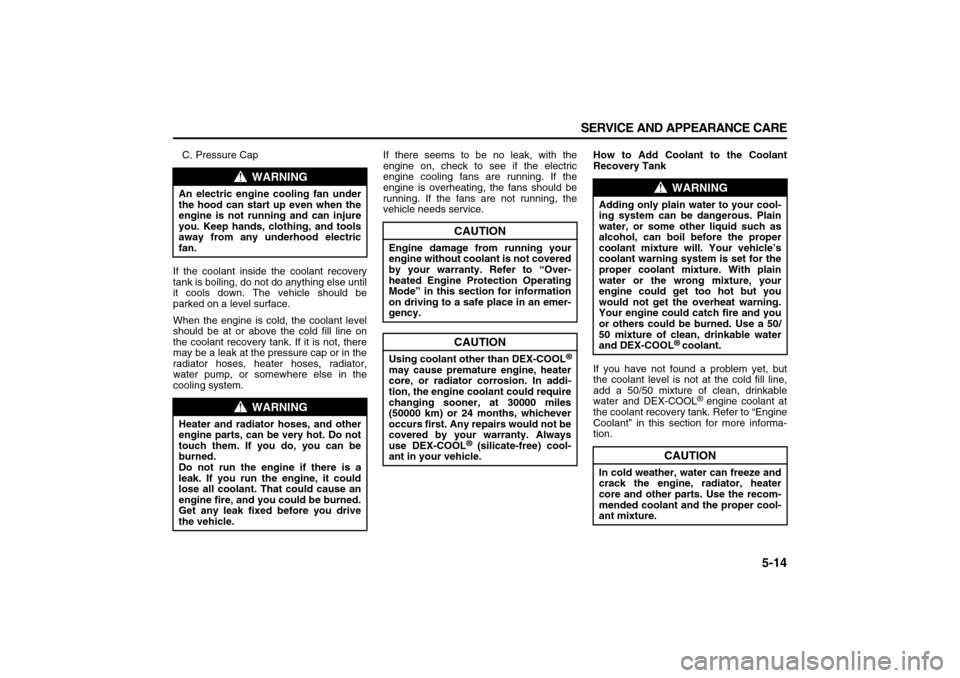
5-14 SERVICE AND APPEARANCE CARE
78J00-03E
C. Pressure Cap
If the coolant inside the coolant recovery
tank is boiling, do not do anything else until
it cools down. The vehicle should be
parked on a level surface.
When the engine is cold, the coolant level
should be at or above the cold fill line on
the coolant recovery tank. If it is not, there
may be a leak at the pressure cap or in the
radiator hoses, heater hoses, radiator,
water pump, or somewhere else in the
cooling system.If there seems to be no leak, with the
engine on, check to see if the electric
engine cooling fans are running. If the
engine is overheating, the fans should be
running. If the fans are not running, the
vehicle needs service.How to Add Coolant to the Coolant
Recovery Tank
If you have not found a problem yet, but
the coolant level is not at the cold fill line,
add a 50/50 mixture of clean, drinkable
water and DEX-COOL
® engine coolant at
the coolant recovery tank. Refer to “Engine
Coolant” in this section for more informa-
tion.
WARNING
An electric engine cooling fan under
the hood can start up even when the
engine is not running and can injure
you. Keep hands, clothing, and tools
away from any underhood electric
fan.
WARNING
Heater and radiator hoses, and other
engine parts, can be very hot. Do not
touch them. If you do, you can be
burned.
Do not run the engine if there is a
leak. If you run the engine, it could
lose all coolant. That could cause an
engine fire, and you could be burned.
Get any leak fixed before you drive
the vehicle.
CAUTION
Engine damage from running your
engine without coolant is not covered
by your warranty. Refer to “Over-
heated Engine Protection Operating
Mode” in this section for information
on driving to a safe place in an emer-
gency.
CAUTION
Using coolant other than DEX-COOL
®
may cause premature engine, heater
core, or radiator corrosion. In addi-
tion, the engine coolant could require
changing sooner, at 30000 miles
(50000 km) or 24 months, whichever
occurs first. Any repairs would not be
covered by your warranty. Always
use DEX-COOL
® (silicate-free) cool-
ant in your vehicle.
WARNING
Adding only plain water to your cool-
ing system can be dangerous. Plain
water, or some other liquid such as
alcohol, can boil before the proper
coolant mixture will. Your vehicle’s
coolant warning system is set for the
proper coolant mixture. With plain
water or the wrong mixture, your
engine could get too hot but you
would not get the overheat warning.
Your engine could catch fire and you
or others could be burned. Use a 50/
50 mixture of clean, drinkable water
and DEX-COOL
® coolant.
CAUTION
In cold weather, water can freeze and
crack the engine, radiator, heater
core and other parts. Use the recom-
mended coolant and the proper cool-
ant mixture.
Page 199 of 274
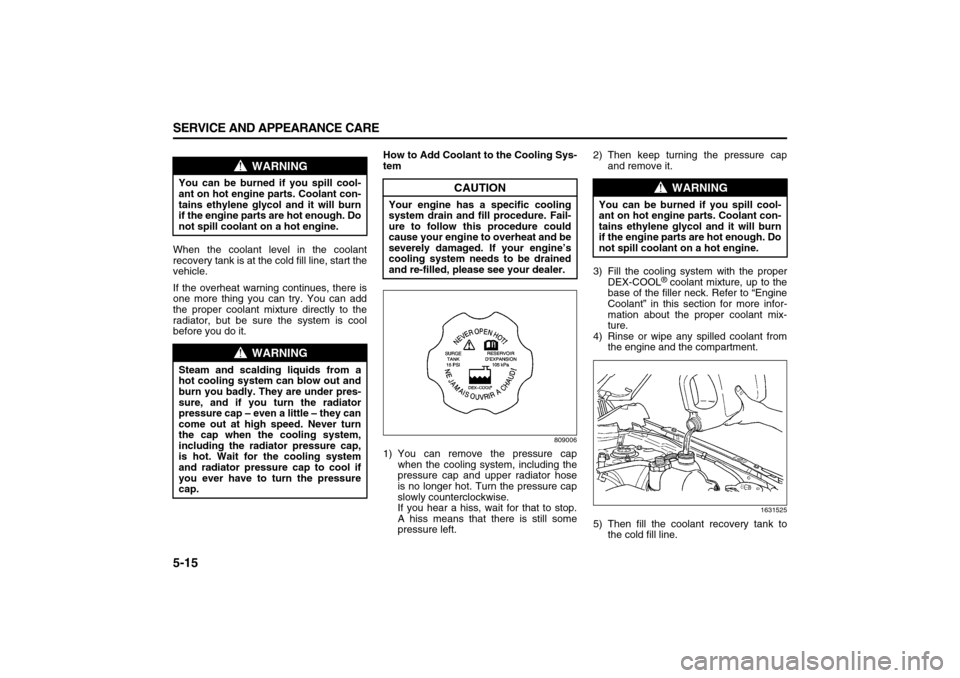
5-15 SERVICE AND APPEARANCE CARE
78J00-03E
When the coolant level in the coolant
recovery tank is at the cold fill line, start the
vehicle.
If the overheat warning continues, there is
one more thing you can try. You can add
the proper coolant mixture directly to the
radiator, but be sure the system is cool
before you do it.How to Add Coolant to the Cooling Sys-
tem
809006
1) You can remove the pressure cap
when the cooling system, including the
pressure cap and upper radiator hose
is no longer hot. Turn the pressure cap
slowly counterclockwise.
If you hear a hiss, wait for that to stop.
A hiss means that there is still some
pressure left.2) Then keep turning the pressure cap
and remove it.
3) Fill the cooling system with the proper
DEX-COOL
® coolant mixture, up to the
base of the filler neck. Refer to “Engine
Coolant” in this section for more infor-
mation about the proper coolant mix-
ture.
4) Rinse or wipe any spilled coolant from
the engine and the compartment.
1631525
5) Then fill the coolant recovery tank to
the cold fill line.
WARNING
You can be burned if you spill cool-
ant on hot engine parts. Coolant con-
tains ethylene glycol and it will burn
if the engine parts are hot enough. Do
not spill coolant on a hot engine.
WARNING
Steam and scalding liquids from a
hot cooling system can blow out and
burn you badly. They are under pres-
sure, and if you turn the radiator
pressure cap – even a little – they can
come out at high speed. Never turn
the cap when the cooling system,
including the radiator pressure cap,
is hot. Wait for the cooling system
and radiator pressure cap to cool if
you ever have to turn the pressure
cap.
CAUTION
Your engine has a specific cooling
system drain and fill procedure. Fail-
ure to follow this procedure could
cause your engine to overheat and be
severely damaged. If your engine’s
cooling system needs to be drained
and re-filled, please see your dealer.
WARNING
You can be burned if you spill cool-
ant on hot engine parts. Coolant con-
tains ethylene glycol and it will burn
if the engine parts are hot enough. Do
not spill coolant on a hot engine.
Page 200 of 274
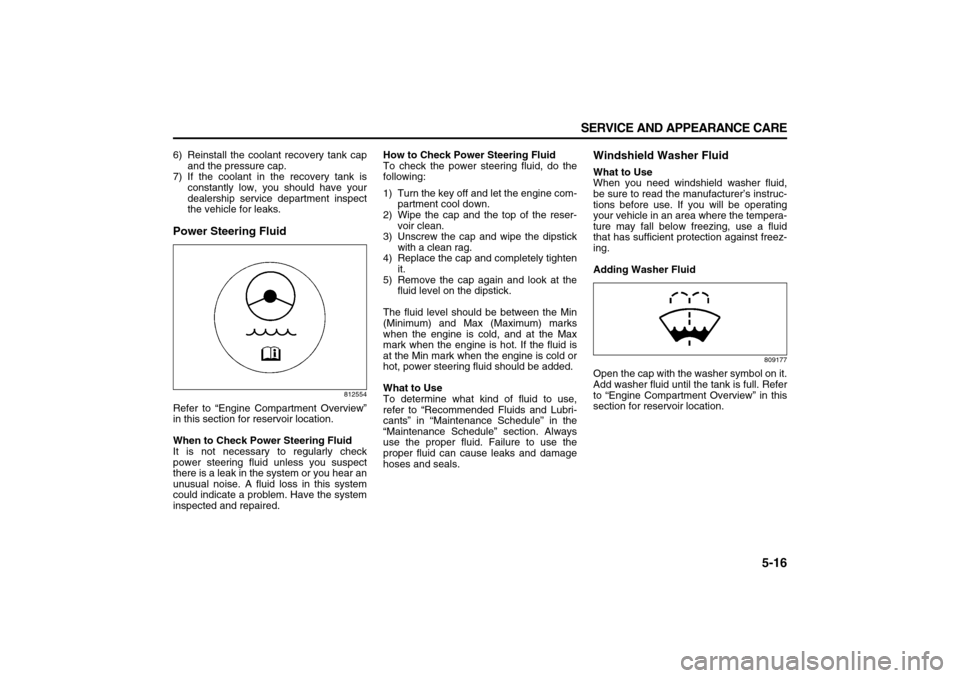
5-16 SERVICE AND APPEARANCE CARE
78J00-03E
6) Reinstall the coolant recovery tank cap
and the pressure cap.
7) If the coolant in the recovery tank is
constantly low, you should have your
dealership service department inspect
the vehicle for leaks.Power Steering Fluid
812554
Refer to “Engine Compartment Overview”
in this section for reservoir location.
When to Check Power Steering Fluid
It is not necessary to regularly check
power steering fluid unless you suspect
there is a leak in the system or you hear an
unusual noise. A fluid loss in this system
could indicate a problem. Have the system
inspected and repaired.How to Check Power Steering Fluid
To check the power steering fluid, do the
following:
1) Turn the key off and let the engine com-
partment cool down.
2) Wipe the cap and the top of the reser-
voir clean.
3) Unscrew the cap and wipe the dipstick
with a clean rag.
4) Replace the cap and completely tighten
it.
5) Remove the cap again and look at the
fluid level on the dipstick.
The fluid level should be between the Min
(Minimum) and Max (Maximum) marks
when the engine is cold, and at the Max
mark when the engine is hot. If the fluid is
at the Min mark when the engine is cold or
hot, power steering fluid should be added.
What to Use
To determine what kind of fluid to use,
refer to “Recommended Fluids and Lubri-
cants” in “Maintenance Schedule” in the
“Maintenance Schedule” section. Always
use the proper fluid. Failure to use the
proper fluid can cause leaks and damage
hoses and seals.
Windshield Washer FluidWhat to Use
When you need windshield washer fluid,
be sure to read the manufacturer’s instruc-
tions before use. If you will be operating
your vehicle in an area where the tempera-
ture may fall below freezing, use a fluid
that has sufficient protection against freez-
ing.
Adding Washer Fluid
809177
Open the cap with the washer symbol on it.
Add washer fluid until the tank is full. Refer
to “Engine Compartment Overview” in this
section for reservoir location.
Page 201 of 274
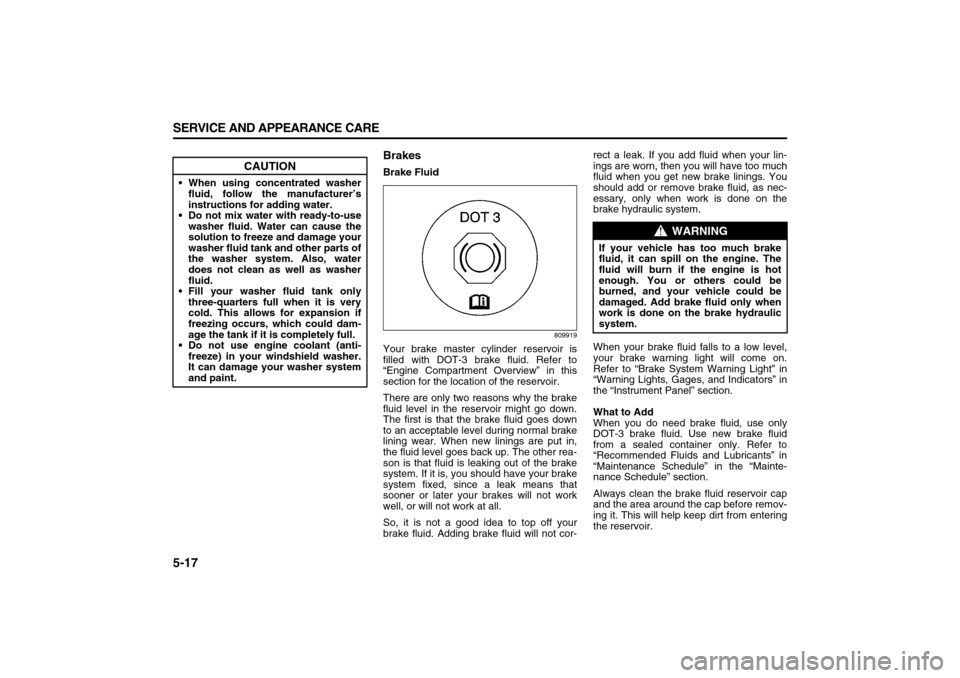
5-17 SERVICE AND APPEARANCE CARE
78J00-03E
BrakesBrake Fluid
809919
Your brake master cylinder reservoir is
filled with DOT-3 brake fluid. Refer to
“Engine Compartment Overview” in this
section for the location of the reservoir.
There are only two reasons why the brake
fluid level in the reservoir might go down.
The first is that the brake fluid goes down
to an acceptable level during normal brake
lining wear. When new linings are put in,
the fluid level goes back up. The other rea-
son is that fluid is leaking out of the brake
system. If it is, you should have your brake
system fixed, since a leak means that
sooner or later your brakes will not work
well, or will not work at all.
So, it is not a good idea to top off your
brake fluid. Adding brake fluid will not cor-rect a leak. If you add fluid when your lin-
ings are worn, then you will have too much
fluid when you get new brake linings. You
should add or remove brake fluid, as nec-
essary, only when work is done on the
brake hydraulic system.
When your brake fluid falls to a low level,
your brake warning light will come on.
Refer to “Brake System Warning Light” in
“Warning Lights, Gages, and Indicators” in
the “Instrument Panel” section.
What to Add
When you do need brake fluid, use only
DOT-3 brake fluid. Use new brake fluid
from a sealed container only. Refer to
“Recommended Fluids and Lubricants” in
“Maintenance Schedule” in the “Mainte-
nance Schedule” section.
Always clean the brake fluid reservoir cap
and the area around the cap before remov-
ing it. This will help keep dirt from entering
the reservoir.
CAUTION
When using concentrated washer
fluid, follow the manufacturer’s
instructions for adding water.
Do not mix water with ready-to-use
washer fluid. Water can cause the
solution to freeze and damage your
washer fluid tank and other parts of
the washer system. Also, water
does not clean as well as washer
fluid.
Fill your washer fluid tank only
three-quarters full when it is very
cold. This allows for expansion if
freezing occurs, which could dam-
age the tank if it is completely full.
Do not use engine coolant (anti-
freeze) in your windshield washer.
It can damage your washer system
and paint.
WARNING
If your vehicle has too much brake
fluid, it can spill on the engine. The
fluid will burn if the engine is hot
enough. You or others could be
burned, and your vehicle could be
damaged. Add brake fluid only when
work is done on the brake hydraulic
system.
Page 245 of 274

6-3 MAINTENANCE SCHEDULE
78J00-03E
Scheduled Maintenance except CANADA
Service Instruction Maintenance I Maintenance II
Change engine oil and filter. Change engine oil and filter if the light/message has not come on
at all for one year.
Refer to “Engine Oil” in “Checking Things Under the Hood” in the
“Service and Appearance Care” section.
••
Reset oil life system.
An Emission Control Service. If the system is ever reset accidentally, perform the maintenance
service within 3000 miles (5000 km) since your last service.
Refer to “Engine Oil Life System” in “Checking Things Under the
Hood” in the “Service and Appearance Care” section.
Visually check for any leaks or
damage. A fluid loss in any vehicle system could indicate a problem.
Have the system inspected and repaired and the fluid level
checked.
Add fluid if needed.••
Rotate tires and check infla-
tion pressures and wear. Rotate tires every 5000 to 8000 miles (8000 to 13000 km).
Refer to “Tire Inspection and Rotation” in “Tires” in the “Service
and Appearance Care” section and “At Least Once a Month” in
this section.••
Inspect brake system. Visually inspect brake lines and hoses for proper hook-up, bind-
ing, leaks, cracks, chafing, etc.
Inspect disc brake pads for wear and rotors for surface condition.
Inspect drum brake linings/shoes for wear or cracks (if equipped).
Inspect other brake parts, including drums, wheel cylinders, cali-
pers, parking brake, etc.
Check parking brake adjustment.••
Check engine coolant and
windshield washer fluid levels
and add fluid as needed.••
Perform any needed addi-
tional services. Refer to “Additional Required Services except CANADA” in this
section.••
Page 249 of 274

6-7 MAINTENANCE SCHEDULE
78J00-03E
Service InstructionMiles (Kilometers)
25000
(40000)50000
(80000)75000
(120000)100000
(160000)125000
(200000)150000
(240000)
Engine cooling system service (or
every five years, whichever occurs
first). An Emission Control Ser-
vice. Drain, flush, and refill cooling
system.
This service can be complex;
you should have your dealer
perform this service.
Refer to “Engine Coolant” in
“Checking Things Under the
Hood” in the “Service and
Appearance Care” section for
what to use.
Inspect hoses.
Clean radiator, condenser, pres-
sure cap, and filler neck.
Pressure test the cooling system
and pressure cap.•
Inspect engine accessory drive
belt. An Emission Control Service. Visually inspect belt for fraying,
excessive cracks, or obvious
damage.
Replace belt if necessary.•
Page 250 of 274

6-8 MAINTENANCE SCHEDULE
78J00-03E
For CANADA Scheduled Maintenance
Service Instruction Maintenance
Change engine oil and filter. Change engine oil and filter if the light/message has not come on at all for 10
months.
Refer to “Engine Oil” in “Checking Things Under the Hood” in the “Service and
Appearance Care” section.
•
Reset oil life system.
An Emission Control Service. If the system is ever reset accidentally, perform the maintenance service within
5000 km since your last service.
Refer to “Engine Oil Life System” in “Checking Things Under the Hood” in the “Ser-
vice and Appearance Care” section.
Visually check for any leaks or
damage. A fluid loss in any vehicle system could indicate a problem.
Have the system inspected and repaired and the fluid level checked.
Add fluid if needed.•
Rotate tires and check infla-
tion pressures and wear. Rotate tires every 8000 to 13000 km.
Refer to “Tire Inspection and Rotation” in “Tires” in the “Service and Appearance
Care” section and “At Least Once a Month” in this section.•
Inspect brake system. Visually inspect brake lines and hoses for proper hook-up, binding, leaks, cracks,
chafing, etc.
Inspect disc brake pads for wear and rotors for surface condition.
Inspect drum brake linings/shoes for wear or cracks (if equipped).
Inspect other brake parts, including drums, wheel cylinders, calipers, parking
brake, etc.
Check parking brake adjustment.•
Check engine coolant and
windshield washer fluid levels
and add fluid as needed.•
Perform any needed addi-
tional services. Refer to “Additional Required Services (For CANADA)” in this section.•
Page 254 of 274

6-12 MAINTENANCE SCHEDULE
78J00-03E
Service InstructionKilometers
40000 80000 120000 160000 200000 240000
Engine cooling system service (or
every five years, whichever occurs
first). An Emission Control Ser-
vice. Drain, flush, and refill cooling
system.
This service can be complex;
you should have your dealer
perform this service.
Refer to “Engine Coolant” in
“Checking Things Under the
Hood” in the “Service and
Appearance Care” section for
what to use.
Inspect hoses.
Clean radiator, condenser, pres-
sure cap, and filler neck.
Pressure test the cooling system
and pressure cap.•
Inspect engine accessory drive
belt. An Emission Control Service. Visually inspect belt for fraying,
excessive cracks, or obvious
damage.
Replace belt if necessary.•